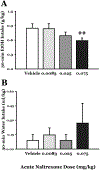Sigma receptor-induced heavy drinking in rats: Modulation by the opioid receptor system
- PMID: 32205151
- PMCID: PMC9551643
- DOI: 10.1016/j.pbb.2020.172914
Sigma receptor-induced heavy drinking in rats: Modulation by the opioid receptor system
Abstract
Alcohol use disorder (AUD) is a major cause of morbidity and mortality worldwide, for which new efficacious treatments are necessary. The opioid receptor system is a mediator of the rewarding effects of alcohol; in particular, while activation of μ opioid receptors enhances ethanol intake in rodents, opioid-receptor antagonists, such as naloxone and naltrexone, reduce its pleasurable and reinforcing effects, thereby decreasing alcohol. Sigma receptors (Sig-Rs) have been proposed as modulators of the effects of alcohol and, therefore, as a potential new pharmacological target for AUD. Somewhat analogously to μ opioid ligands, SigR agonists increase, while SigR antagonists decrease alcohol intake in animal models of excessive alcohol drinking. However, a potential cross-talk between these two receptor systems in relation to alcohol consumption has so far not been investigated. Here, we addressed this question pharmacologically, by testing the effects of either activating or inhibiting opioid receptors on the heavy alcohol drinking induced by chronic stimulation of SigR in alcohol-preferring rats. We found that the opioid receptor agonist morphine, which per se increases ethanol intake, at a sub-threshold dose reduces the binge-like drinking induced by the repeated treatment with the SigR agonist 1,3-di-o-tolylguanidine (DTG); conversely, the opioid receptor antagonist naltrexone, which per se reduces ethanol intake, at a sub-threshold dose potentiates the DTG-induced binge-like drinking. Our data show a cross-talk between the opioid and SigR systems relevant to the modulation of alcohol drinking, which provides important insights into the neurobiology of AUD and may lead to the development of novel therapies, either standalone or in combination.
Keywords: Addiction; Alcohol OR ethanol; Animal model; Binge; Morphine; Naltrexone; Rat; Self-administration.
Copyright © 2020. Published by Elsevier Inc.
Conflict of interest statement
Declaration of competing interest The authors declare no conflict of interest. M. Valenza is currently an employee of Epitech Group S.p.A., Saccolongo, Italy.
Figures




Similar articles
-
Activation of σ-receptors induces binge-like drinking in Sardinian alcohol-preferring rats.Neuropsychopharmacology. 2011 May;36(6):1207-18. doi: 10.1038/npp.2011.5. Epub 2011 Feb 23. Neuropsychopharmacology. 2011. PMID: 21346735 Free PMC article.
-
Evidence that Melanocortin Receptor Agonist Melanotan-II Synergistically Augments the Ability of Naltrexone to Blunt Binge-Like Ethanol Intake in Male C57BL/6J Mice.Alcohol Clin Exp Res. 2015 Aug;39(8):1425-33. doi: 10.1111/acer.12774. Epub 2015 Jun 24. Alcohol Clin Exp Res. 2015. PMID: 26108334 Free PMC article.
-
Pharmacological characterization of the 20% alcohol intermittent access model in Sardinian alcohol-preferring rats: a model of binge-like drinking.Alcohol Clin Exp Res. 2013 Apr;37(4):635-43. doi: 10.1111/acer.12008. Epub 2012 Nov 5. Alcohol Clin Exp Res. 2013. PMID: 23126554 Free PMC article.
-
Endogenous opioid systems and alcohol addiction.Psychopharmacology (Berl). 1997 Jan;129(2):99-111. doi: 10.1007/s002130050169. Psychopharmacology (Berl). 1997. PMID: 9040115 Review.
-
Opiates and alcohol self-administration in animals.J Clin Psychiatry. 1995;56 Suppl 7:5-14. J Clin Psychiatry. 1995. PMID: 7673105 Review.
Cited by
-
Editorial: Kappa opioid receptors revealed: Disentangling the pharmacology to open up new therapeutic strategies.Front Pharmacol. 2022 Aug 12;13:973780. doi: 10.3389/fphar.2022.973780. eCollection 2022. Front Pharmacol. 2022. PMID: 36034837 Free PMC article. No abstract available.
-
Novel Highly Potent and Selective Sigma1 Receptor Antagonists Effectively Block the Binge Eating Episode in Female Rats.ACS Chem Neurosci. 2020 Oct 7;11(19):3107-3116. doi: 10.1021/acschemneuro.0c00456. Epub 2020 Sep 21. ACS Chem Neurosci. 2020. PMID: 32886484 Free PMC article.
-
Antagonism of Sigma-1 receptor blocks heavy alcohol drinking and associated hyperalgesia in male mice.Alcohol Clin Exp Res. 2021 Jul;45(7):1398-1407. doi: 10.1111/acer.14635. Epub 2021 Jul 5. Alcohol Clin Exp Res. 2021. PMID: 34060104 Free PMC article.
-
Diverse saturated heterocycles from a hydroacylation/conjugate addition cascade.Chem Sci. 2022 Jan 19;13(5):1504-1511. doi: 10.1039/d1sc06900d. eCollection 2022 Feb 2. Chem Sci. 2022. PMID: 35222935 Free PMC article.
References
-
- Abbott FV, Franklin KB, Libman RB, 1986. A dose-ratio comparison of mu and kappa agonists in formalin and thermal pain. Life Sci. 39 (21), 2017–2024. - PubMed
-
- Alonso G, Phan V, Guillemain I, Saunier M, Legrand A, Anoal M, Maurice T, 2000. Immunocytochemical localization of the sigma(1) receptor in the adult rat central nervous system. Neuroscience 97 (1), 155–170. - PubMed
-
- Altshuler HL, Phillips PE, Feinhandler DA, 1980. Alteration of ethanol self-administration by naltrexone. Life Sci. 26 (9), 679–688. - PubMed
-
- Ault DT, Werling LL, 1997. Differential modulation of NMDA-stimulated [3H]dopamine release from rat striatum by neuropeptide Y and sigma receptor ligands. Brain Res 760 (1–2), 210–217. - PubMed
-
- Ault DT, Radeff JM, Werling LL, 1998. Modulation of [3H]dopamine release from rat nucleus accumbens by neuropeptide Y may involve a sigma1-like receptor. J. Pharmacol. Exp. Ther 284 (2), 553–560. - PubMed
Publication types
MeSH terms
Substances
Grants and funding
LinkOut - more resources
Full Text Sources
Research Materials

